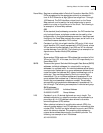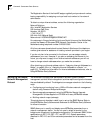
Storing Configuration Parameter Values 6-17
For more information on IP configuration, refer to Reference for NETBuilder Family
Software.
4 Enable IP routing by entering:
SETDefault -IP CONTrol = RO
5 Enable a routing protocol. For example, to enable RIP use:
SETDefault !<port> -RIPIP CONTrol = (Listen, Talk)
This step is optional.
6 Ensure your configuration by verifying that the bridge/router can access other
devices on the network, use:
PING <IP address>
where <IP address> is the IP address of another device on the network.
Storing Configuration
Parameter Values
Configuration parameters are stored in flash memory or on the disk of another
server (for example, the TFTP/FTP server that boots the bridge/router). In this
guide, the term “disk” refers to either the local flash memory drive or the hard
disk on another server.
When the bridge/router is booted, it copies configuration parameters from the
disk to memory. Parameter values on the disk are default values and values in
memory are active values. You can alter the default and active values with the
SETDefault and SET commands. For more information, refer to Reference for
NETBuilder Family Software.
When the new value of a parameter takes effect depends on whether its active
value has been changed. Some commands change the active value only, some
change the default value, and some change both. If you display the parameter
after modifying it and see the new value, the new value has taken effect
immediately. If a command changes only the default value, the new value takes
effect only after reboot. In this guide, if the description does not specify when the
new value of a parameter takes effect after being enabled or disabled, it is
effective immediately after it is set.
Obtaining Network
Manager Privilege
Level
Before changing the Network Manager password, you must obtain Network
Manager privilege.
To display or change the privilege level, follow these steps:
1 To determine the current privilege level, enter:
SHow PRIvilege
If the following message is displayed, you already have Network Manager
privilege:
PRIvilege = NetMgr
If the following message is displayed, go to step 2:
PRIvilege = User
You also can determine the privilege level from the NETBuilder prompt. The
following prompt is displayed at the Network Manager privilege level:
NETBuilder #


















